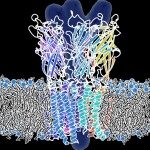Link to Pubmed [PMID] – 16087736
Link to HAL – Click here
Link to DOI – 10.1093/nar/gki730
Nucleic Acids Res. 2005;33(14):4496-506
Prediction of structural changes resulting from complex formation, both in ligands and receptors, is an important and unsolved problem in structural biology. In this work, we use all-atom normal modes calculated with the Elastic Network Model as a basis set to model structural flexibility during formation of macromolecular complexes and refine the non-bonded intermolecular energy between the two partners (protein-ligand or protein-DNA) along 5-10 of the lowest frequency normal mode directions. The method handles motions unrelated to the docking transparently by first applying the modes that improve non-bonded energy most and optionally restraining amplitudes; in addition, the method can correct small errors in the ligand position when the first six rigid-body modes are switched on. For a test set of six protein receptors that show an open-to-close transition when binding small ligands, our refinement scheme reduces the protein coordinate cRMS by 0.3-3.2 A. For two test cases of DNA structures interacting with proteins, the program correctly refines the docked B-DNA starting form into the expected bent DNA, reducing the DNA cRMS from 8.4 to 4.8 A and from 8.7 to 5.4 A, respectively. A public web server implementation of the refinement method is available at http://lorentz.immstr.pasteur.fr.

